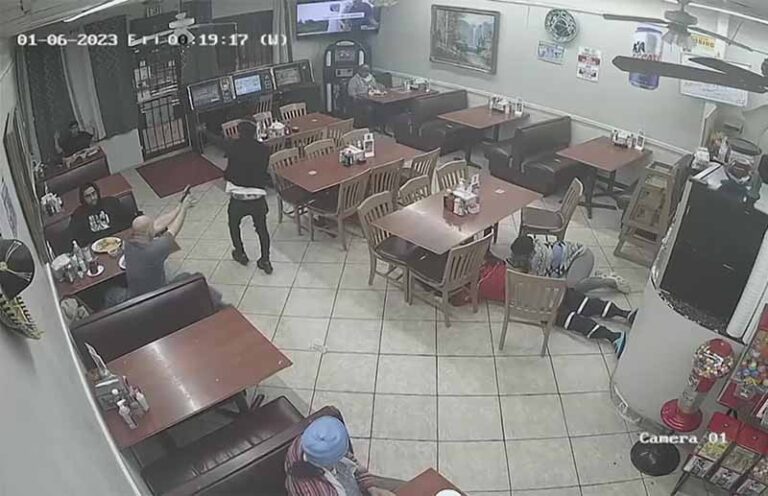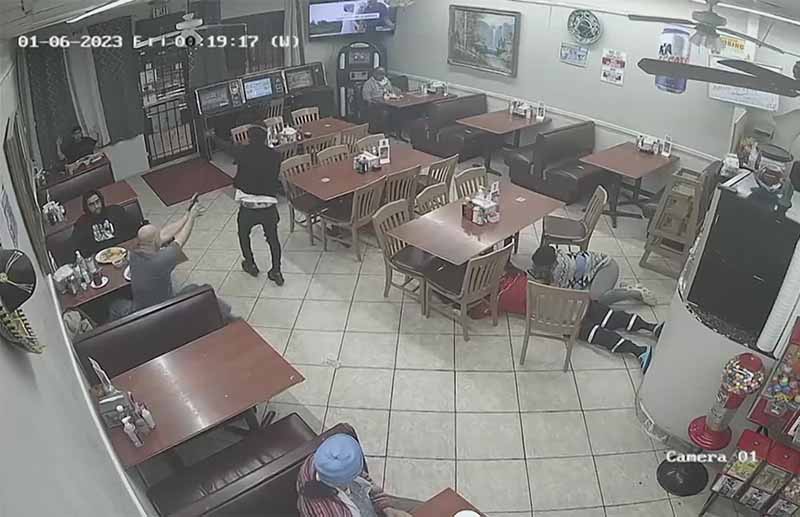
A closer look at the Texas taqueria shooting reveals that when it comes to self-defense, sometimes the devil is in the details.
“Customer Shoots Robber in Houston” is what the headlines say. In fact, if you Google that phrase, you will find the video showing the incident. Many of the search results show news stories that include the video edited to not show the actual shooting, but if you dig deep enough, you can find the unedited footage.
It’s worth finding that video. But, was it justified?
At first blush, it’d appear so—but the customer (who, at the time of this writing, has yet to be identified), does a remarkable job of attempting to snatch defeat from the jaws of victory.

A Legal Look
First off, the robber was using a fake gun. This fact could be used to suggest that deadly force by the shooter was not warranted, but even a first-year law school student could successfully argue this point. The elements of the crime of robbery include the taking of property by the threatening of illegal force, and here the robber was clearly using illegal force to take property. (He actually committed several robberies, as he took money from several individuals while threatening them with deadly force.)
Even though the gun was fake, if the victim believed it was real, that’s enough to fulfill the elements of the crime of robbery. And, if the shooter felt his life or the life of someone else was in imminent danger, then the shooting would be justified.
At first, the shooter complied with the robbery request, throwing an object on the floor (presumably his wallet). The robber then went on to take possessions from the other patrons of the taqueria. As the robber was leaving and at the moment of the shooting, one can see that the robber is still threatening one patron as he moved toward the door, so shooting the robber (even in the back) was clearly justified because he was threatening the life of another patron.
If the gun had not been fake, however, I wonder if the robber would have shot the patron upon being struck in the back by the gunfire. Most instructors I know would advise not shooting when a gun is being held either on you or someone else due to the very real possibility of a spasm of the hand causing the gun to fire. Nevertheless, I think most would agree that the first shot was justified. After that, it gets problematic from a legal standpoint.
Complicating Factors
The video shows the shooter drawing and firing four rapid fire shots into the back of the robber as the robber makes his way to the door. A closer look at the first four shots shows that, after the second shot, the robber wasn’t threatening anyone, including the shooter. The robber is falling flat on his face and clearly not a threat, but he receives two more shots as he’s falling.
Were these shots necessary? A case could be made for either argument.
Then, the shooter gets up and follows the robber, shooting him an additional four times as he laid on the ground. Next, the shooter picks up the fake gun and, moments after doing so, the shooter fires one more shot toward the downed robber’s head.
A total of nine shots were fired by the shooter. A couple of seconds after the first four shot in rapid fire, another four shots were fired in a more deliberate manner—about one per second. Were these shots justified?
If these shots weren’t justified, how does that work against the necessity that any use of force, including deadly force, must be reasonable under the circumstances? This will be the question for the prosecutor or the grand jury to answer.
Now, if that isn’t problematic enough, the shooter then fires one more shot “toward the head” of the downed robber. I wonder if that last shot was the fatal one fired? If so, I can see an indictment and prosecution.
Questionable Actions
But wait, there’s more! The actions by the shooter—after all the shooting was done—don’t favor the shooter, either. The shooter leaned over the robber, retrieved the fake gun from where it had fallen and, upon seeing it was a fake plastic gun, threw it against a wall and broke it—not exactly a calm display of mindset. He then took the money back from the robber, put it on one of the tables and told the patrons to take their money back. The shooter then leaves, and as he walked by the robber, threw his coffee cup down upon the now likely deceased robber.
Remember the adage “flight equals guilt?” It looks bad; a reasonable person wouldn’t likely have driven away from the scene.
According to news reports, the shooter will be facing a grand jury, to determine if criminal charges will be brought against him. The outcome of that grand jury proceeding will heavily rest upon the local district attorney. The old law school saying is that a prosecutor could indict a ham sandwich if he so chooses. Here, I believe there is sufficient evidence to push charges against the shooter, but also evidence that weighs toward a justifiable homicide.
It will be interesting to watch how the Texas taqueria shooting unfolds.
Editor's Note: This article originally appeared in the 2023 CCW special issue of Gun Digest the Magazine.
Know Your Rights:

Next Step: Get your FREE Printable Target Pack
Enhance your shooting precision with our 62 MOA Targets, perfect for rifles and handguns. Crafted in collaboration with Storm Tactical for accuracy and versatility.
Subscribe to the Gun Digest email newsletter and get your downloadable target pack sent straight to your inbox. Stay updated with the latest firearms info in the industry.

![Best Concealed Carry Guns In 2025 [Field Tested] Wilson Combat EDC X9S 1](https://gundigest.com/wp-content/uploads/Wilson-Combat-EDC-X9S-1-324x160.jpg)


![Best 9mm Carbine: Affordable PCCs [Tested] Ruger Carbine Shooting](https://gundigest.com/wp-content/uploads/Ruger-Carbine-Shooting-100x70.jpg)
![Best AR-15: Top Options Available Today [Field Tested] Harrington and Richardson PSA XM177E2 feature](https://gundigest.com/wp-content/uploads/Harrington-and-Richardson-PSA-XM177E2-feature-100x70.jpg)

People fake death and just because you fire your gun does not mean you hit the guy with bullets. People miss, you know. Even up close. The only way to know for sure is if you actually see carnage on the body (such as the head).
Was the shooter justified. In a way yes and because we don’t know what would have happened if he had a real gun puts the onus on the robber, not the actual shooter. Sorry, but let the man go because his actions shows that when armed he shoots the bad guys and not the good guys.
Frankly, in my opinion they should give the shooter a medal for taking out the trash…but unfortunately our INjustice system doesn’t see it that way.